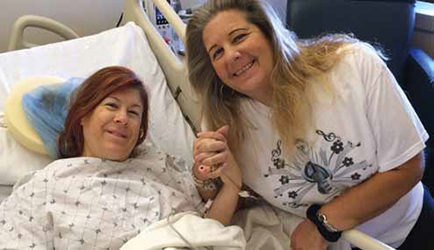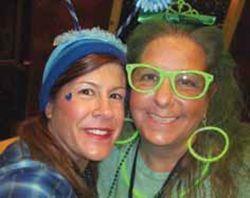Jan Doherty, 53, of Frederick, Md., and Michele Pothier, 43, of Gainesville, Fla., aren’t the sort of relatives that usually make donor kidneys compatible—but they do have a “sister” in common. An alt-rock band called Sister Hazel brought the two together through concerts and events over the years. When Jan told Michele that she had been waiting for a new kidney for two years after being diagnosed with kidney disease, Michele was eager to help her fellow “Hazelnut”—the nickname for the band’s many fans.
“I researched what it would mean for me to donate a kidney,” says Michele. “I looked at all the possible outcomes and realized that even if I didn’t match Jan, if we did the paired exchange, it would still help someone.”
So Michele reached out to Jan. “‘What would you think if I gave you one of my kidneys?’ She couldn’t believe I would want to. But she’s family to me,” says Michele.
Although Michele was not a good match for Jan, both joined the National Kidney Registry to do a paired exchange. Joining as a donor-recipient pair makes finding a suitable match easier than when a single recipient registers on their own.
And then surprise news came just a week before Jan’s scheduled paired surgery: A perfect kidney was available from a deceased donor. Jan struggled, knowing that coordination of ideal matches is more difficult to accomplish if one person drops out of the paired registry pool. It breaks the chain of donations and transplants.

Matthew Cooper, MD, director of Kidney and Pancreas Transplantation at the MedStar Georgetown Transplant Institute, and Jennifer Verbesey, MD, director of the Living Donor Kidney Transplant program at MedStar Georgetown Transplant Institute, impressed on Jan how suitable the new match was. “The donor was 18 years old, the kidney was very healthy, and it was an excellent match,” Dr. Verbesey says. “Jan didn’t want to ruin the donation chain. But we strongly advised her to take the option with the best possible chance for a great outcome.” Jan agreed and Dr. Verbesey performed Jan’s surgery in September 2015.
Jan’s removal from the chain of exchanges meant Michele was no longer committed to the paired exchange program. And yet Michele decided to donate her healthy kidney to an unknown person awaiting a transplant in California. MedStar Georgetown Transplant Surgeon Seyed Ghasemian, MD, performed Michele’s procedure. “She was a very pleasant young lady with the usual giving nature and dedication of a living donor,” Dr. Ghasemian says with pride.
Dr. Ghasemian estimates that only about 10 percent of the donor pool offers one of their kidneys to a stranger. MedStar Georgetown Transplant Institute has an outreach program to encourage people to donate, but he says organ shortage is still a serious problem.
Michele was impressed with her experience at MedStar Georgetown. “Everything flowed very smoothly, like a well-oiled machine,” she says. “The whole thing took about four hours. Even recovery was easy.”
“I’m so happy that two lives were saved,” Michele says. “People ask if I feel different. My heart feels a little bigger, and I feel great.”
Learn more about kidney transplantation at MedStar Georgetown Transplant Institute.

